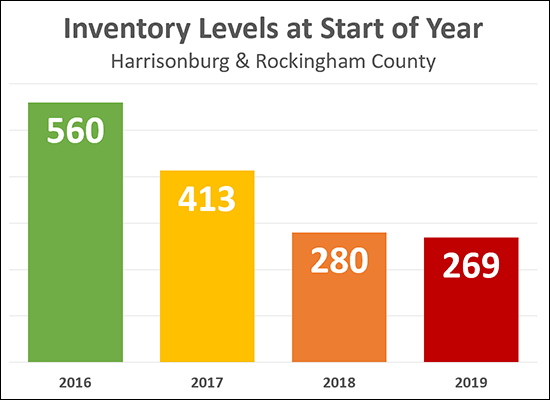Brought to you by Scott P. Rogers, Funkhouser Real Estate Group, 540-578-0102, scott@HarrisonburgHousingToday.com
Brought to you by Scott P. Rogers, Funkhouser Real Estate Group, 540-578-0102, scott@HarrisonburgHousingToday.com
Tuesday, January 15, 2019

Inventory levels have fallen rather consistently over the past several years:
- Start of 2016 = 560 homes for sale
- Start of 2017 = 413 homes for sale
- Start of 2018 = 280 homes for sale
And yet -- somehow -- buyers were able to buy pretty much the same number of homes for each of the past three years:
- 2016 = 1313 home sales
- 2017 = 1261 home sales
- 2018 = 1302 home sales
So -- what gives? How does this work? Does it matter that inventory levels are much lower now than they have been over the past few years?
Let's ignore, for the moment, any homes that come on the market and never sell and are taken back of the market. If we do so, then the information above might mean:
2016 = 1166 New Listings?
Starting the year with 560 homes for sale, and selling 1313 during the year, and ending the year with 413 homes on the market would mean that around 1166 owners listed their homes for sale in 2016.
(560 + 1166 - 1313 = 413)
2017 = 1128 New Listings?
Starting the year with 413 homes for sale, and selling 1261 during the year, and ending the year with 280 homes on the market would mean that around 1128 owners listed their homes for sale in 2017.
(413 + 1128 - 1261 = 280)
2018 = 1291 New Listings?
Starting the year with 280 homes for sale, and selling 1302 during the year, and ending the year with 269 homes on the market would mean that around 1291 owners listed their homes for sale in 2018.
(280 + x - 1302 = 269)
So -- after all that --
Lower inventory levels at the beginning of the year (560 to 413 to 280) and during the year did not seem to affect the number of buyers who were able to find homes to buy. Sales stayed consistent-ish over the past three years despite these declining inventory levels.
But --
Lower inventory levels make it less fun to be a buyer. Buyers have fewer choices at any given time and they will often have competition from other buyers when the home of their dream comes on the market.
Lower inventory levels make the market move faster. With fewer options to choose from, buyers must be ready to act quickly. We saw this with a reduction in the median days on market over the past several years from 52 days to 33 days to 25 days.
So, yes, lower housing inventory levels do matter -- mostly to buyers. Sellers are, usually, quite delighted to have lower inventory levels when they are ready to sell. Sellers will have less competition, and more likely to sell more quickly and negotiate less.
